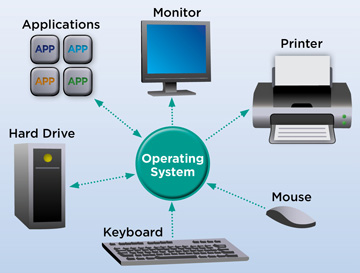An operating system (OS) is system software that manages computer hardware and provides a variety of essential functions for both users and other software. Here are some of its key features and functions:
Process Management: The OS manages multiple processes, allowing them to run concurrently, scheduling CPU time for each, and providing a stable environment for execution.
Memory Management: It allocates and deallocates memory for processes, ensuring efficient use of available RAM and virtual memory.
File System Management: The OS provides a hierarchical file system for data storage, including functions for creating, reading, writing, and deleting files.
Device Management: It controls and communicates with hardware devices such as printers, disks, and input/output peripherals, providing a uniform interface for applications to interact with hardware.
User Interface: Most operating systems offer a user-friendly interface, like a graphical user interface (GUI) or command-line interface (CLI), to interact with the system and applications.
Security and Access Control: OSs enforce user permissions and security policies, safeguarding data and preventing unauthorized access.
Networking: They support network communication, allowing devices to connect, share resources, and access remote services.
Error Handling: Operating systems monitor system errors, report them, and attempt to recover gracefully from errors without crashing the system.
File and Data Protection: OSs implement file permissions and encryption to protect data from unauthorized access or corruption.
System Resource Allocation: They manage CPU, memory, and other resources to ensure fair and efficient resource allocation among multiple processes.
Task Scheduling: The OS schedules tasks to maximize CPU utilization, throughput, and response time, using various scheduling algorithms.
System Updates and Maintenance: It supports system updates, patches, and maintenance to improve performance, security, and stability.
Interprocess Communication: OSs facilitate communication between processes, allowing them to share data and coordinate tasks.
In summary, an operating system serves as an intermediary between hardware and software, offering essential functions that enable users to interact with their computers effectively and efficiently. The specific features and functions may vary depending on the type of operating system (e.g., Windows, macOS, Linux) and its intended use (e.g., desktop, server, embedded systems).
